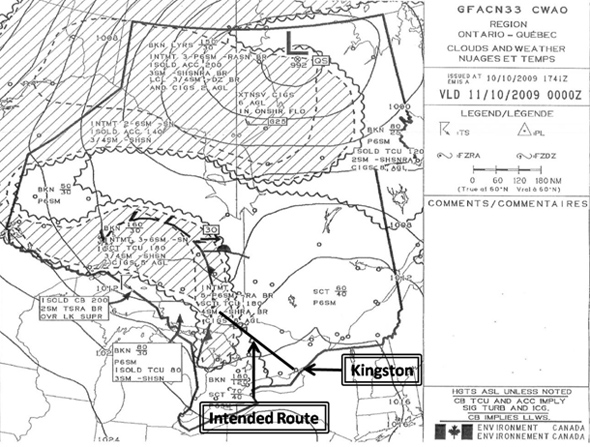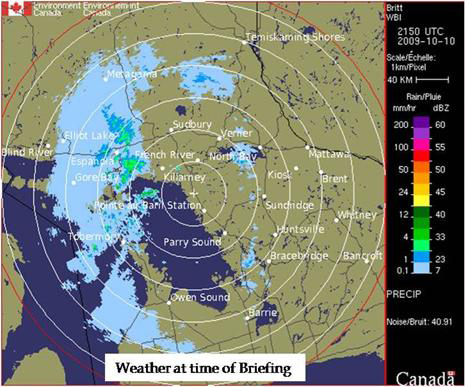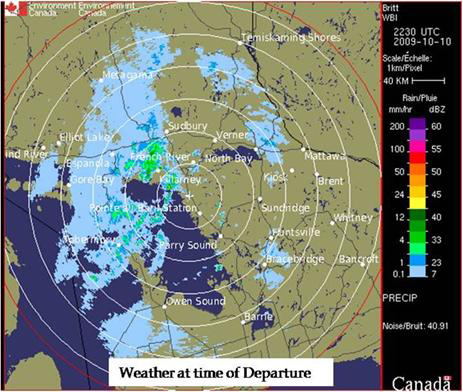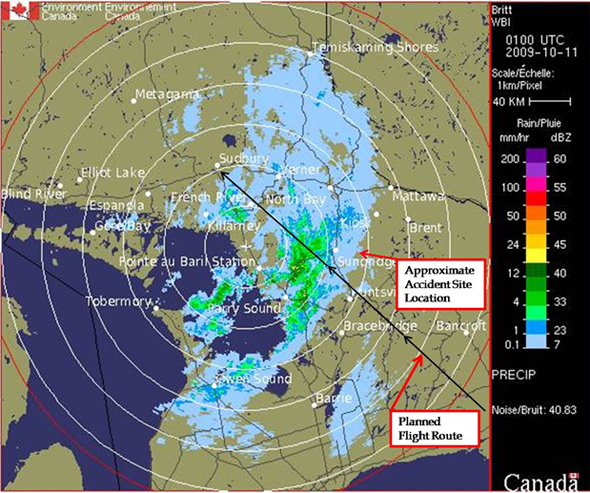Controlled Flight into Terrain
Tracks & Wheels Equipment Brokers Inc.
Piper PA-28R-180, C-FURX
South River, Ontario, 22 sm E
The Transportation Safety Board of Canada (TSB) investigated this occurrence for the purpose of advancing transportation safety. It is not the function of the Board to assign fault or determine civil or criminal liability. This report is not created for use in the context of legal, disciplinary or other proceedings. See Ownership and use of content. Masculine pronouns and position titles may be used to signify all genders to comply with the Canadian Transportation Accident Investigation and Safety Board Act (S.C. 1989, c. 3).
Summary
The Piper PA-28R-180 aircraft (C-FURX, serial number 28R30535) departed Kingston, Ontario, at 1827 Eastern Daylight Time on a night visual flight rules (VFR) flight to Sudbury, Ontario. On board the aircraft were the pilot and three passengers. The estimated time of arrival at Sudbury was 2042. At 2052, an emergency locator transmitter signal was reported by an overflying aircraft. Upon confirmation that the aircraft had not arrived at Sudbury, the Trenton Joint Rescue Coordination Centre was notified and a search initiated. The aircraft was located the following day at 0302, approximately 22 statute miles east of South River, Ontario. All four occupants were fatally injured.
Other Factual Information
History of Flight
On the day of the occurrence, the pilot contacted the London Flight Information Centre (FIC) to obtain a weather briefing for a visual flight rules flight from Sudbury to Kingston, with a view to returning to Sudbury in the evening. During the briefing, the pilot was informed that a cold front was moving in from the west, extending north to south, and would reach Sudbury at approximately 2000 Footnote 1. Ahead of the front, the forecast was for showers and a ceiling of 3000 feet above sea level (asl). As the briefing continued, the pilot was advised that if the arrival in Sudbury was before dark, the weather would remain suitable for a VFR flight. However, after dark, the forecast called for isolated, towering cumulus clouds and a visibility of 3 miles in light snow showers. In Sudbury, the sunset was to be at 1847 and twilight at 1917. At 1132, the pilot contacted the London FIC for a second time, filed a flight plan for Kingston and also obtained an updated weather forecast for the return flight to Sudbury. The aircraft departed Sudbury at 1208 and arrived in Kingston at 1357.
At 1655, the pilot phoned the London FIC to obtain a weather briefing for the return flight from Kingston to Sudbury. The pilot planned on departing Kingston at 1800, with an estimated time of arrival in Sudbury between 2000 and 2030.
At 1755, the pilot placed a second call to the London FIC to file a VFR flight plan. The flight plan indicated that it was to be a VFR flight direct to Sudbury, with airspeed of 135 knots and a time en route of 2 hours and 15 minutes. The estimated time of arrival in Sudbury was 2042, with 3.5 hours of fuel on board. The aircraft departed Kingston at 1827. The last radio contact occurred as the aircraft was leaving the Kingston control zone.
The pilot did not contact the Montreal Area Control Centre (ACC) to request radar service. The radar system available to the Montreal ACC did, however, record the first 30 minutes of the flight, as the aircraft departed Kingston and became established en route. The last radar hit recorded by the Montreal ACC was at 1852. The aircraft was on a direct track to Sudbury at 3000 feet asl .
The aircraft first appeared on the North Bay radar at 1937. It was approximately 30 nautical miles (nm) north of the direct track to Sudbury and at 2400 feet asl . The last radar contact occurred at 1941. The aircraft was approximately 3 nm south east of the accident site at 2100 feet asl . During the last four minutes of radar coverage, there were several heading changes, mainly from westerly to northwesterly in direction.
At 2052, the Toronto ACC contacted the Trenton Joint Rescue Coordination Centre (JRCC) to report that emergency locator transmitter (ELT) signals were being received by an overflying aircraft. At 2139, the London FIC reported that the aircraft was overdue, that the Sudbury flight service station (FSS) had not made radio contact with the aircraft and that a ramp check confirmed the aircraft had not arrived at the Sudbury Airport.
The coordinates for the previous two radar contacts were provided to Search and rescue aircrafts, which arrived in the area of the accident at 0015 on 11 October 2009. Poor local weather conditions hampered the search. The aircraft was located at 0302.
Wreckage Information
The accident site was located near the western boundary of Algonquin Park. The terrain was hilly, with ground elevations up to 1750 feet asl . The hills were covered with 80 to 100 foot tall hardwood trees. The main wreckage was located approximately at the mid-point of a tree covered hill, at an elevation of 1660 feet asl . The aircraft was at a near-level altitude when it began to strike the tops of trees, which were located at the base of a gulley prior to rising terrain. Substantial aircraft break-up occurred and several parts of the aircraft were identified along the wreckage trail leading to the main wreckage. The wreckage trail measured approximately 300 feet in length. Heavier components, such as the engine and propeller, were located beyond the main wreckage. The aircraft was intact prior to tree impact and the engine was developing power. Due to the extent of the debris field, the amount of damage and the large number of leaves on the ground, investigators were unable to locate several key instruments such as the aircraft altimeter.
Aircraft Information
Records indicate that the aircraft was certified, equipped and maintained in accordance with existing regulations and approved procedures. Navigation equipment included a Garmin GPS MAP 696. This model offered the satellite weather option (subject to a 15 minute delay) as well as a terrain/moving map feature. Damage to the GPS unit precluded the downloading of data. It is therefore unknown whether these features were used. The aircraft was not equipped with a Terrain Awareness Warning System (TAWS), nor was it required to be by regulation.
Pilot Information
The pilot held a valid private pilot licence for single engine land and seaplanes. The last pilot logbook entry was dated 23 August 2009. The pilot had accumulated 205.4 hours of total time, broken down as follows:
| Day/Dual | Day/PIC Footnote 2 | Night/Dual | Night/PIC |
|---|---|---|---|
| 102.8 | 79.9 | 17.2 | 5.5 |
The pilot had completed the required training and applied for a night rating; however, there were no records to indicate that Transport Canada had received the application. A rating had not been issued either. Part of this night training included a night time cross-country flight from Sudbury to Kingston with an instructor. This was done on 5 June 2009, which was the last time the pilot had flown at night prior to the accident. Based on logbook entries, this occurrence was to be the pilot’s first night time cross-country flight as pilot-in-command. The pilot did not hold an instrument flight rules (IFR) rating.
The investigation found no evidence to indicate that the pilot’s performance was impacted by physiological factors.
Weather Information
At 1655, the pilot phoned the London FIC to confirm if the forecast weather for Sudbury had improved. The London FIC provided information derived from the Graphical Area Forecast (GFA) for the Ontario/Québec region at 1341, which was valid for use from 2000 onward (see Figure 1).
A cold front stretching from east of Sault Ste. Marie northward to Timmins was the major meteorological influence.
East of the cold front, in the area stretching from Algonquin Park southeast toward Kingston, the GFA was forecasting:
- scattered clouds based at 4000 feet, with tops between 6000 and 7000 feet asl ; and
- visibility of more than six miles.
Immediately east of the cold front, the GFA was forecasting the following:
- ceilings of 800 feet above ground level (agl);
- visibility of 4 statute miles (sm) in light rain showers and mist;
- scattered, towering cumulus clouds with tops at 18 000 feet asl ; and
- intermittent visibilities from 5 to more than 6 sm in light rain and mist.
Immediately west of the cold front, the GFA was calling for:
- ceilings of 500 feet agl;
- visibility of ¾ sm in light snow showers;
- scattered, towering cumulus clouds with tops at 18 000 feet asl ;
- intermittent visibilities from 3 to 6 sm in light snow; and
- layer of broken cloud based at 3000 feet asl and topped at 16 000 feet asl .
Further west, the GFA called for:
- visibilities of 3 sm in light snow showers;
- isolated, towering cumulus clouds topped at 8000 feet asl ;
- elsewhere visibilities greater than 6 sm ; and
- broken cloud layer based at 3000 feet asl and topped at 8000 feet asl .
The cold front was moving east at 30 knots, doubling in speed from the previous GFA . It was estimated to arrive in the Sudbury area at about the same time as the flight. The cold front had passed Sault Ste. Marie earlier. The ceiling was recorded as 800 feet agl, with a visibility of 3 sm in snow showers.
The pilot and the London FIC discussed departing Kingston to arrive in Sudbury before the front moved in and considered North Bay as an alternate destination, which was 59 nm to the east of Sudbury.
At 1755, the pilot placed a second call to the London FIC to file a VFR flight plan. When asked if weather or other information was needed, the pilot referred to the previously obtained briefing. Having already acquired weather information and made the decision to undertake the flight, the pilot inquired about any changes for Sudbury. Information derived from the Sudbury terminal aerodrome forecast (TAF) and weather radar was provided.
The TAF for Sudbury, within the timeframe of the flight, was as follows:
- from 1800, wind 220 degrees true at 12 knots gusting 22, visibility of greater than 6 sm and cloud at 5000 feet broken; and
- temporarily from 1800 to 2200, visibility of 5 sm with light rain showers and mist, as well as a broken cloud layer at 2000.
The weather radar at Sudbury displayed weak returns toward the west, indicating isolated rain showers. The London FIC also provided abbreviated weather reports for Gore Bay and a variety of airports to the west of Sudbury. The London FIC indicated that the weather conditions for Sudbury, at the time of arrival, were forecast to be favourable and that any precipitations would be very light.
The NAV CANADA Flight Services Manual of Operations (FS MANOPS) requires flight service specialists to acquire insight into a pilot’s intentions and requirements, as well as provide the necessary related briefings. The pilot did not request the aviation routine weather reports (METAR) or special reports (SPECI) Footnote 3 in full for various stations near the route of flight, including reported altimeter settings and winds aloft. Paragraph 305.4E of the FS MANOPS requires flight service specialists to provide “details of surface weather observations, aerodrome forecast, forecast winds and temperatures.” However, the specialist has the discretion to provide additional weather information, even if it may not be entirely consistent with the pilot’s stated requirements; Footnote 4 no additional information was provided.
At the time of the occurrence, the weather in the vicinity of the accident included a mixture of rain and snow, as well as gusting wind conditions, estimated to be in excess of 25 knots.
Route Information
The pilot planned a direct route from Kingston to Sudbury. Initial radar returns indicate that the pilot was following the planned route and with such precision as to suggest the on‑board GPS was used as the primary navigational aid. While navigation charts were on board, it is unknown whether the pilot made use of them during pre-flight planning or while en route.
The flight departed Kingston at 1827. Civil twilight for the Kingston area was calculated to end at 1859. With the exception of the first thirty two minutes, the flight was conducted at night.
The selected route took the aircraft over terrain that provided fewer and fewer features as the flight progressed northwest of Kingston. Visual navigation would have been challenging at night. Any lights on the ground that could have assisted the pilot would have been sparse and, based on forecast and reported weather conditions, may not have been visible.
The planned route would take the aircraft over higher terrain. The Kingston airport elevation is 303 feet asl . The flight would have overflown areas, with maximum elevation figures Footnote 5 ranging from 1700 to as high as 2400 feet asl . A direct route would have taken the aircraft over spot elevations as high as 1875 feet asl in Algonquin Park.
The planned route of flight provided few ground stations from which the pilot could obtain updated weather information or ask for assistance. These ground stations were Kingston, North Bay, Muskoka and Sudbury. Successful radio communications would be subject to the line-of-sight limitations of the very high frequency (VHF) transceivers used in civil aviation.
If the aircraft were to maintain an altitude of 3000 feet asl , the theoretical radio range Footnote 6 would have precluded communications with both North Bay, located 50 nm northwest of the accident site, and Muskoka, located 65 nm southwest of the accident site.
The aircraft exited the Kingston area level at 2500 feet asl . It later climbed to 3000 feet asl where it remained until initial radar coverage was lost. The first hit recorded by the North Bay radar was at 1937, when the aircraft was shown at an altitude of 2400 feet asl . The last radar hit was at 1941 at an altitude of 2100 feet asl . As the flight progressed, the aircraft descended over rising terrain where the theoretical VHF range would have been even lower. The pilot’s only recourse would have been to attempt to communicate with an overflying aircraft on a common frequency with which information could have been relayed. It is unknown whether this was attempted.
Aircraft Altimeters
Aircraft altimeters are calibrated to indicate true altitude when International Standard Atmosphere (ISA) Footnote 7 conditions exist.
Actual conditions typically vary from ISA conditions. As a result, the indicated altitude will differ from the actual height of the aircraft above mean sea level. For differences in pressure, altimeters incorporate a controllable subscale, which a pilot can set to the actual barometric pressure. Section 602.35 of the Canadian Aviation Regulations requires pilots to set altimeters:
- to the setting or elevation of the aerodrome before taking off;
- to the setting of the nearest station along the route of flight or, where the nearest stations along the route of flight are separated by more than 150 nautical miles, to the altimeter setting of a station near the route of flight; and
- to the altimeter setting of the aerodrome before commencing a descent for landing, if the setting is obtainable.
For differences in temperature, calculations would have to be made. If the actual temperature is lower than standard, as was the case in this occurrence, the true altitude would be lower than indicated.
Analysis
Examination of the aircraft revealed no pre-impact faults, and all damage was a result of several tree and ground impacts. The aircraft was in controlled level flight when it struck the trees. This analysis focuses on the weather as well as the pilot’s experience and decision making.
The major part of the occurrence flight was to be conducted at night. While documents indicated the required training to obtain a night rating had been completed, the pilot’s license had not yet been endorsed. The pilot had minimal experience flying at night. The pilot had flown this trip before with his instructor, and the aircraft was equipped with a GPS . The pilot likely felt capable of undertaking the flight, notwithstanding the navigational challenges of flying at night over areas that provided few useable visual aids.
Good VFR weather persisted in Kingston for the entire day of 10 October 2009. Between the time the pilot first contacted the London FIC for a weather briefing and the time of departure from Kingston, the visibility was 15 sm and there was no ceiling. There were only a few clouds at 6000 feet and scattered cloud at 25 000 feet.
Before calling the London FIC for a weather briefing prior to departing Kingston, the pilot had already inferred that the forecast conditions for Sudbury were improving.
The pilot’s first phone call to the London FIC for a weather briefing occurred 1.5 hours prior to the actual departure from Kingston. The briefer informed the pilot of the forecast weather that could be encountered ahead and behind the cold font. The briefer also indicated that the front was expected in the Sudbury area at about the same time as the aircraft’s planned arrival.
The pilot obtained a weather briefing by phone and, in all likelihood, did not have the GFA to refer to, thereby precluding any visualization of the weather. Otherwise, the pilot would have seen that the forecast weather associated with the front would be encountered en route, well before reaching the frontal surface and destination. The pilot likely assumed the weather to be strictly associated with frontal passage, hence the decision to leave as soon as possible to arrive in Sudbury before the front. Moreover, based on the briefing, the pilot focused almost exclusively on the destination forecast weather, to the exclusion of the weather forecast reported elsewhere along the flight route.
Having created a weather image an hour earlier, the pilot’s subsequent conversation with the London FIC suggested more favourable forecast conditions in Sudbury. This may have served to confirm the pilot’s initial decision. Here again, the exchanges between the pilot and the briefer focused exclusively on the forecast at the destination and not en route.
There was no radio contact with the aircraft after it left the Kingston control zone. The aircraft altitude likely did not exceed 3000 feet asl throughout the duration of the flight. Flight at that altitude would have made radio contact with en route ground stations difficult, if not impossible. Even if radio contact was possible, there were few weather reporting stations from which the pilot could had made a reasonable reassessment of the conditions and reviewed the decision to continue toward the destination.
The initial part of the flight was along a direct line from Kingston to Sudbury, indicating the pilot was likely navigating via the onboard GPS . When the aircraft was subsequently picked up by the North Bay radar, it was significantly north of the desired track. The aircraft was also descending with frequent heading changes. This suggests the pilot was navigating around cloud and/or terrain, trying to find a clear route between the clouds and the hills. Although the aircraft was north of the initial Sudbury track, it was on a westerly heading when it struck trees, rather than a northerly heading towards the alternate airport in North Bay. This suggests the pilot was still attempting to proceed to the destination.
Originally shaped as a line from north to south, the weather system was moving from west to east. It covered an area from Southwest Ontario to north of Sudbury (see Appendix A.) The heaviest concentration of precipitation was at the front, where there were no weather reporting stations. A mixture of rain, snow and strong winds were also present. As it moved east, the front began to change shape and appeared to be more convex. This meant that, at the outer tips, the weather was not as severe and any available weather reports were not indicative of the actual weather likely encountered by the pilot (see Appendix B).
The front was changing in appearance while the aircraft was en route and there were no weather updates available to compel a re-evaluation of the pilot’s decision. The aircraft was flying from good night VFR weather conditions into deteriorating weather conditions. Visibility would have been reduced as the cloud deck dropped and the precipitation increased. This, combined with the fact that Algonquin Park has very few light sources to provide ground reference, would have made it difficult for the pilot to maintain visual reference with the ground. The pilot was not IFR rated, so climbing into and, perhaps, above the cloud to divert to North Bay was not an option.
At the time of departure, the altimeter setting in Kingston was 30.04. This information was relayed to the pilot on departure. The pilot later reported leaving the Kingston area, level at 2500 feet asl , which was confirmed by radar. The aircraft subsequently climbed to 3000 feet asl , which was maintained until initial radar coverage was lost. These radar plots suggest the aircraft altimeter was in all likelihood set to 30.04.
As the aircraft was likely out of VHF range, the pilot would have been unable to obtain any updated weather en route, including the latest altimeter settings. It is unknown whether any attempts were made. At the time of departure from Kingston, the altimeter setting for Sudbury was 29.90.
The pilot had not obtained altimeter settings for stations along the flight route during the weather briefings. The planned route would take the aircraft over rising terrain and toward an area of lower pressure. The temperatures were also below ISA . Therefore, if left untouched, the altimeter would have read approximately 130 feet higher than the actual altitude of the aircraft. The last radar return showed the aircraft at 2100 feet asl , but the aircraft descended further. The aircraft stuck trees that were 80 to 100 feet higher than the terrain, which was at approximately 1750 feet. When the aircraft began to strike the tree tops, its true altitude would have been 1850 feet asl . The aircraft’s altimeter would have read 1980 feet asl and any margin of obstacle clearance the pilot may have thought existed, did not.
The following TSB Laboratory report was completed:
- LP 138/2009 – GPS Analysis
This report is available from the Transportation Safety Board of Canada upon request.
Findings
Findings as to Causes and Contributing Factors
- The pilot, with minimal night flying experience, took off at night without fully appreciating the marginal weather that was forecast en route.
- The pilot planned the flight over inhospitable terrain that afforded few visual cues for VFR navigation and continued flying into deteriorating weather conditions.
- The pilot likely encountered conditions where ground reference was lost and altitude was not maintained, resulting in the aircraft striking trees in an area of rising terrain.
- The altitude at which the aircraft was flown precluded radio communication with ground stations along the flight route. This increases the risk that pilots may be unable to obtain critical flight information on a timely basis.
- The failure to apply current altimeter settings along the flight route, particularly from an area of high to low pressure, may result in reduced obstacle clearance.
Other Finding
- Although the pilot had the required training for a night rating, there was no documentation found that a night rating had been issued by Transport Canada.
This report concludes the Transportation Safety Board’s investigation into this occurrence. Consequently, the Board authorized the release of this report on .



